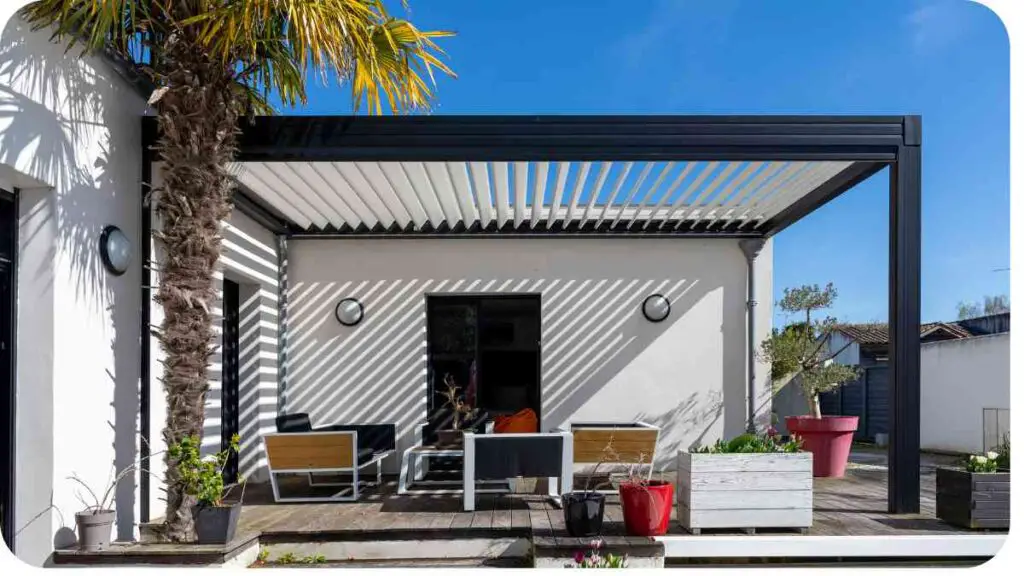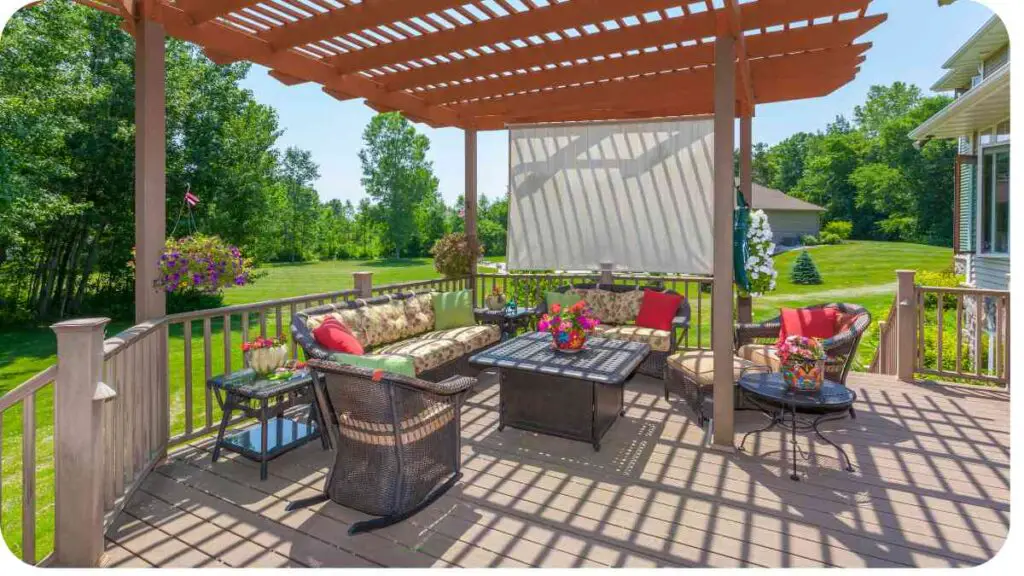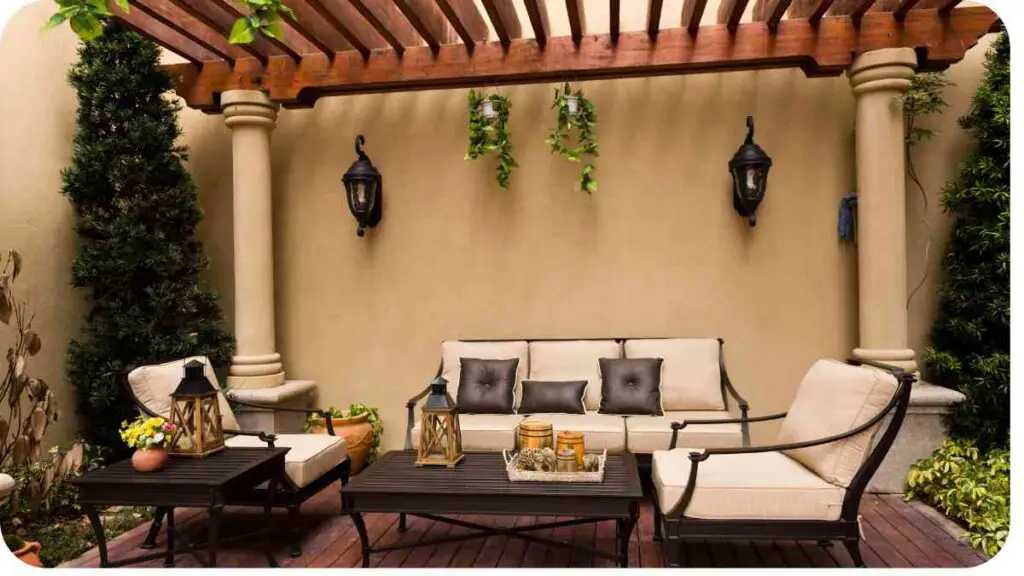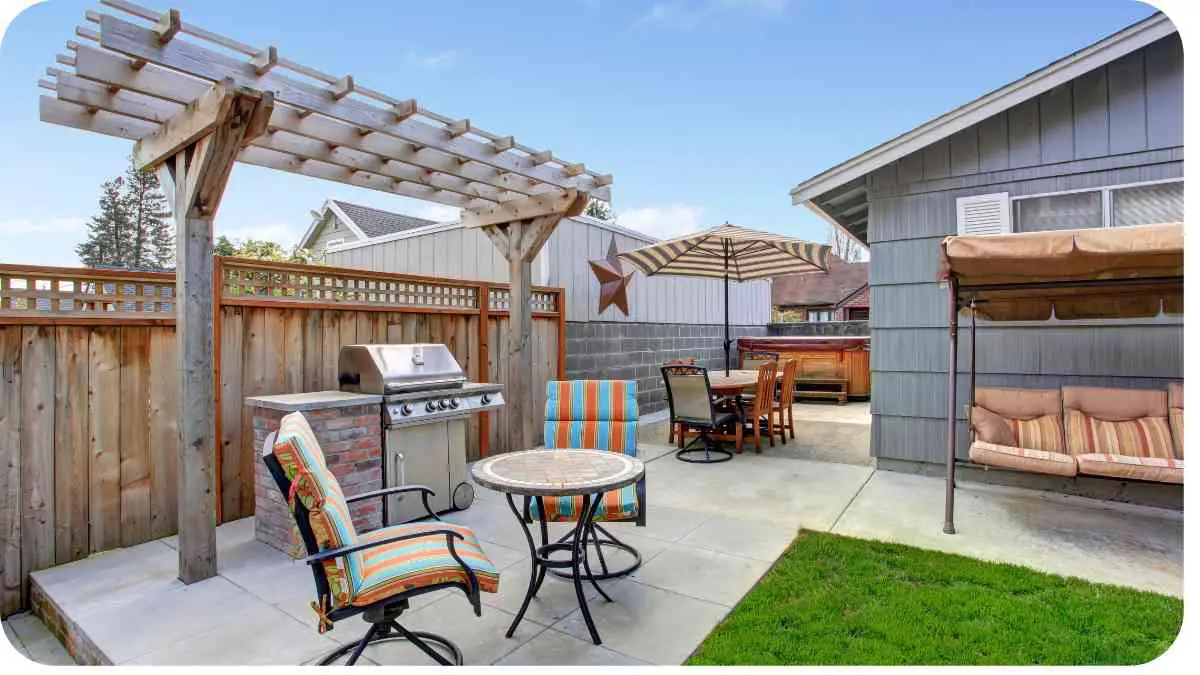Are you craving more space to enjoy the great outdoors while still being protected from the elements? Extending your covered patio might just be the solution you’re looking for.
In this guide, we’ll walk you through everything you need to know to successfully expand your outdoor living area and create a functional and stylish extension that suits your needs.
But before we dive in, let’s briefly discuss the dimensions commonly used for patio extensions.
| Takeaways |
|---|
| 1. Assess your needs before planning your patio extension to ensure it meets your requirements. |
| 2. Consider factors such as size, materials, and design style when planning your patio extension. |
| 3. Obtain necessary permits and permissions from local authorities before starting construction. |
| 4. Decide whether to hire professionals or DIY based on your budget, timeline, and skill level. |
| 5. Budget carefully and account for materials, labor, permits, and additional features in your project. |
| 6. Proper site preparation is essential for a successful patio extension project. |
| 7. Follow a structured construction process, including framing, roofing, flooring, and finishing touches. |
| 8. Weatherproofing and insulation are critical to protect your patio extension from the elements. |
| 9. Choose durable and weather-resistant furniture and decor for your patio extension. |
| 10. Incorporate various lighting elements to enhance the ambiance of your outdoor space. |
| 11. Regular maintenance is key to preserving the beauty and functionality of your patio extension. |
| 12. Explore further resources and inspiration for patio extension ideas and planning. |
2. Assessing Your Needs
Table: Common Patio Extension Dimensions
| Size (feet) | Suitable For |
|---|---|
| 10×10 | Small gatherings, intimate spaces |
| 12×20 | Medium-sized gatherings |
| 20×30 | Large gatherings, outdoor dining |
When planning your patio extension, consider the size that best accommodates your typical activities and the available space in your yard. Now, let’s move on to the planning phase.
Transform your outdoor seating with vibrant colors and textures. Elevate your relaxation game with our comprehensive guide to outdoor cushion makeover!
3. Planning Your Patio Extension

When it comes to planning your patio extension, one of the crucial decisions you’ll need to make is choosing the right materials. Let’s compare some common options:
Table: Materials Comparison
| Material | Pros | Cons |
|---|---|---|
| Wood | Natural look, customizable, versatile | Requires regular maintenance |
| Concrete | Durable, low maintenance, various finishes | Can crack over time, limited design options |
| Pavers | Easy to install, versatile, budget-friendly | May shift over time, weeds can grow |
| Composite | Low maintenance, durable, eco-friendly | Higher initial cost, limited color options |
Consider factors such as durability, maintenance requirements, and aesthetic appeal when selecting the material for your patio extension. Now, let’s explore some design considerations.
4. Design Considerations
Choosing the right design for your patio extension is essential to create a space that complements your home’s architecture and suits your lifestyle. Here are some popular styles to consider:
Experience cozy evenings under the stars with a fire pit. Discover how to extend your outdoor season by creating a covered patio with a fire pit.
Table: Popular Patio Extension Styles
| Style | Description |
|---|---|
| Gable | Features a pitched roof with two sloping sides, providing ample space |
| Flat Roof | Modern and minimalist design, ideal for contemporary homes |
| Hip Roof | Sloping roof with all sides, offering a more traditional aesthetic |
| Attached Pergola | Adds elegance and shade with open lattice roof structure |
Each style has its unique characteristics and advantages, so choose one that aligns with your preferences and outdoor space. Next, let’s discuss the importance of obtaining permits and permissions before starting construction.
5. Obtaining Permits and Permissions
Before breaking ground on your patio extension project, it’s crucial to ensure compliance with local building codes and regulations. This typically involves obtaining permits and permissions from your municipality. Failure to do so could result in costly fines or having to dismantle the extension.
Make sure to check with your local authorities regarding any zoning restrictions, setback requirements, and other regulations that may apply to your project. It’s better to invest time in securing the necessary permits upfront than to encounter legal issues later on.
6. Hiring Professionals vs. DIY

Once you have your plans in place and necessary permits obtained, you’ll need to decide whether to hire professionals or tackle the project yourself. Let’s weigh the pros and cons of each option:
Beat the heat without breaking the bank. Explore our budget-friendly options for shade patio covers and enjoy your outdoor oasis comfortably.
Table: Pros and Cons Comparison
| Aspect | Hiring Professionals | DIY |
|---|---|---|
| Expertise | Professional craftsmanship | Limited experience, potential mistakes |
| Time | Faster completion | Time-consuming, learning curve |
| Cost | Higher upfront cost, potential savings | Lower upfront cost, hidden expenses |
| Convenience | Less hassle, project management provided | Full control, potential stress |
Consider your budget, timeline, and skill level when making this decision. While hiring professionals offers convenience and expertise, DIY projects allow for customization and potential cost savings. Now, let’s delve into budgeting and cost estimation for your patio extension.
7. Budgeting and Cost Estimation
Budgeting is a critical aspect of any home improvement project, and extending your covered patio is no exception. Factors that can impact the cost include materials, labor, permits, and any additional features or amenities you plan to include.
Start by researching the cost of materials and obtaining quotes from contractors if you’re hiring professionals. Don’t forget to budget for unexpected expenses or contingencies to avoid overspending. It’s also a good idea to set aside funds for any future maintenance or repairs.
By carefully planning and budgeting for your patio extension, you can ensure that the project stays within your financial means and meets your expectations. Next, let’s discuss the steps involved in preparing the site for construction.
8. Preparing the Site
Before construction can begin on your patio extension, proper site preparation is essential to ensure a smooth and successful project. Here are some steps to consider:
- Clearing the Area: Remove any existing structures, debris, or vegetation from the site to create a clean workspace.
- Grading the Ground: Ensure the ground is level and properly graded to prevent water drainage issues.
- Marking Boundaries: Use stakes and string to outline the perimeter of the extension to guide construction.
- Underground Utilities: Identify and mark the location of underground utilities to avoid accidental damage during excavation.
Taking the time to prepare the site thoroughly will help minimize delays and complications during the construction process. Now, let’s move on to the construction phase.
Illuminate your outdoor sanctuary with elegant LED lighting solutions. Learn how to enhance your gazebo’s ambiance with our guide to LED gazebo lighting.
9. Construction Process
Once the site is prepared, it’s time to start building your patio extension. Depending on the complexity of your design and materials chosen, the construction process may vary. Here’s a general overview of what to expect:
- Framing: Begin by constructing the framework for the extension, including support beams and posts.
- Roofing: Install the roofing material, whether it’s shingles, metal panels, or another option, to provide protection from the elements.
- Flooring: Lay down the flooring material, such as concrete, pavers, or decking, to create a functional surface for your patio.
- Walls (if applicable): If your design includes walls, build them according to your plans, taking care to ensure proper insulation and weatherproofing.
- Finishing Touches: Add any additional features, such as lighting, fans, or decorative elements, to enhance the functionality and aesthetics of your patio extension.
Throughout the construction process, be sure to adhere to safety protocols and quality standards to ensure a durable and long-lasting patio. Once construction is complete, it’s time to focus on weatherproofing and insulation.
10. Weatherproofing and Insulation
Weatherproofing and insulation are essential steps to protect your patio extension from the elements and ensure year-round comfort. Here are some key considerations:
- Roof Sealant: Apply a waterproof sealant to the roofing material to prevent leaks and water damage.
- Insulation: Install insulation in the walls and ceiling to regulate temperature and improve energy efficiency.
- Weather Stripping: Seal gaps and cracks around doors and windows with weather stripping to prevent drafts and moisture intrusion.
By weatherproofing and insulating your patio extension, you can create a comfortable and inviting outdoor space that you can enjoy regardless of the weather. Next, let’s discuss choosing furniture and decor for your extended patio.
Maximize your backyard coverage with top-rated canopies. Discover the best options for 12 by 12 canopies to create a shaded retreat for your outdoor gatherings.
11. Choosing Furniture and Decor

Selecting the right furniture and decor is key to creating a welcoming and functional outdoor living space. Consider the following factors when choosing furnishings for your patio extension:
- Durability: Opt for outdoor furniture made from weather-resistant materials such as teak, aluminum, or resin wicker to withstand exposure to the elements.
- Comfort: Choose cushions and upholstery with weather-resistant fabrics that are easy to clean and maintain.
- Style: Coordinate the style and color scheme of your furniture and decor with the overall design aesthetic of your patio extension.
Table: Patio Furniture Types Comparison
| Furniture Type | Description | Pros | Cons |
|---|---|---|---|
| Dining Sets | Includes table and chairs for outdoor dining | Ideal for hosting meals outdoors | Limited versatility |
| Lounge Seating | Features sofas, loveseats, and chairs for lounging | Comfortable and relaxing | Requires space |
| Bistro Sets | Compact dining sets for small spaces | Perfect for intimate gatherings | Limited seating options |
| Hammocks | Suspended beds for ultimate relaxation | Space-saving and unique | Requires sturdy support |
Once you’ve chosen your furniture, add decorative elements such as outdoor rugs, throw pillows, and potted plants to personalize your patio extension and create a cozy atmosphere. Now, let’s shed some light on the importance of lighting and ambiance.
12. Lighting and Ambiance
Lighting plays a crucial role in setting the mood and ambiance of your outdoor space, especially during evening gatherings or late-night relaxation sessions. Here are some lighting options to consider:
- String Lights: Hang string lights above your patio to create a warm and inviting glow.
- Lanterns: Place lanterns along pathways or on tables to add a charming touch to your patio decor.
- Wall Sconces: Install wall sconces to provide ambient lighting and enhance the overall aesthetic of your patio extension.
- Solar Lights: Use solar-powered lights to illuminate walkways and landscaping without the need for electricity.
Table: Lighting Options Comparison
| Lighting Option | Description | Pros | Cons |
|---|---|---|---|
| String Lights | Creates a cozy atmosphere with soft illumination | Easy to install, versatile | Requires power source |
| Lanterns | Adds decorative flair and ambient lighting | Portable and versatile | May require batteries |
| Wall Sconces | Provides focused lighting and enhances aesthetics | Hardwired for permanent installation | Professional installation |
| Solar Lights | Eco-friendly and cost-effective lighting solution | No electricity required | Limited brightness |
By incorporating various lighting elements, you can transform your patio extension into a captivating outdoor oasis that you can enjoy day or night. Now, let’s explore some maintenance tips to keep your patio looking its best for years to come.
13. Maintenance Tips
Maintaining your patio extension is essential to preserve its beauty and functionality over time. Here are some maintenance tips to keep in mind:
- Regular Cleaning: Sweep or hose down your patio regularly to remove dirt, debris, and leaves. For stubborn stains, use a mild detergent and water solution.
- Sealant Inspection: Periodically inspect the sealant on your patio’s roofing material to ensure it remains intact and effective in preventing leaks.
- Furniture Care: Clean outdoor furniture regularly and store cushions and upholstery indoors during inclement weather to prevent damage.
- Inspect for Damage: Check for signs of wear and tear such as cracks, rot, or loose screws, and address any issues promptly to prevent further damage.
By staying proactive with maintenance tasks, you can prolong the lifespan of your patio extension and enjoy it for years to come. Now, let’s wrap up with a brief conclusion.
14. Conclusion
Extending your covered patio is a fantastic way to enhance your outdoor living space and create a functional and stylish extension that suits your lifestyle. By following the steps outlined in this guide, from planning and construction to furnishing and maintenance, you can successfully transform your patio into a versatile and inviting retreat.
Remember to assess your needs, plan carefully, and enlist the help of professionals when needed to ensure a smooth and successful project. With proper design, materials, and maintenance, your extended patio will become a cherished part of your home where you can relax, entertain, and enjoy the beauty of the outdoors.
Further Reading
- Skylift Hardware: Patio Roof Extension Ideas and Planning: Explore a variety of patio roof extension ideas and get helpful planning tips from Skylift Hardware.
- Houzz: Patio with a Roof Extension Ideas: Browse through a collection of inspiring patio designs featuring roof extensions on Houzz.
- The Patio Company: Top Backyard Patio Extension Ideas: Discover top backyard patio extension ideas and design inspiration from The Patio Company.
FAQs
How do I plan a patio extension?
To plan a patio extension, start by assessing your needs, considering the available space, and choosing suitable materials and design styles.
What materials are commonly used for patio extensions?
Common materials for patio extensions include wood, concrete, pavers, and composite decking. Each material has its own pros and cons in terms of durability, maintenance, and aesthetic appeal.
Do I need permits for a patio extension?
Yes, you may need permits and permissions from your local municipality before constructing a patio extension. It’s essential to check with your local authorities to ensure compliance with building codes and regulations.
Should I hire professionals or DIY for my patio extension?
The decision to hire professionals or DIY depends on factors such as expertise, time, and budget. Professionals offer expertise and convenience, while DIY projects allow for customization and potential cost savings.
How do I maintain a patio extension?
To maintain a patio extension, regularly clean the surface, inspect for damage, and perform necessary repairs. Additionally, protect furniture and decor from the elements and ensure proper drainage to prevent water damage.

I am Hellen James, a professional handywoman with expertise in improving home and garden spaces by using pergolas, gazebos, and tents.


